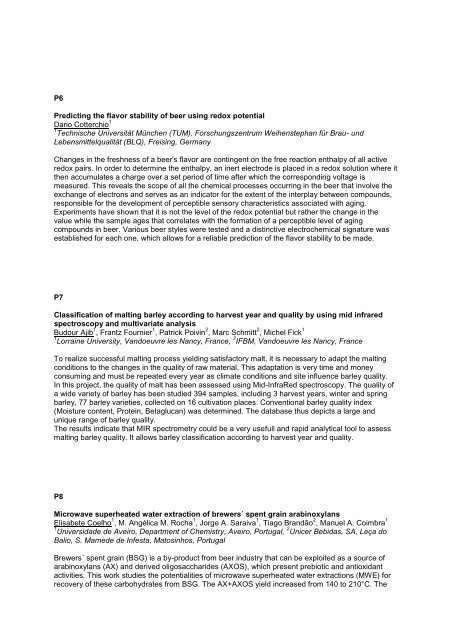here - the 34th European Brewery Convention
here - the 34th European Brewery Convention
here - the 34th European Brewery Convention
You also want an ePaper? Increase the reach of your titles
YUMPU automatically turns print PDFs into web optimized ePapers that Google loves.
P6<br />
Predicting <strong>the</strong> flavor stability of beer using redox potential<br />
Dario Cotterchio 1<br />
1 Technische Universität München (TUM), Forschungszentrum Weihenstephan für Brau- und<br />
Lebensmittelqualität (BLQ), Freising, Germany<br />
Changes in <strong>the</strong> freshness of a beer's flavor are contingent on <strong>the</strong> free reaction enthalpy of all active<br />
redox pairs. In order to determine <strong>the</strong> enthalpy, an inert electrode is placed in a redox solution w<strong>here</strong> it<br />
<strong>the</strong>n accumulates a charge over a set period of time after which <strong>the</strong> corresponding voltage is<br />
measured. This reveals <strong>the</strong> scope of all <strong>the</strong> chemical processes occurring in <strong>the</strong> beer that involve <strong>the</strong><br />
exchange of electrons and serves as an indicator for <strong>the</strong> extent of <strong>the</strong> interplay between compounds,<br />
responsible for <strong>the</strong> development of perceptible sensory characteristics associated with aging.<br />
Experiments have shown that it is not <strong>the</strong> level of <strong>the</strong> redox potential but ra<strong>the</strong>r <strong>the</strong> change in <strong>the</strong><br />
value while <strong>the</strong> sample ages that correlates with <strong>the</strong> formation of a perceptible level of aging<br />
compounds in beer. Various beer styles were tested and a distinctive electrochemical signature was<br />
established for each one, which allows for a reliable prediction of <strong>the</strong> flavor stability to be made.<br />
P7<br />
Classification of malting barley according to harvest year and quality by using mid infrared<br />
spectroscopy and multivariate analysis<br />
Budour Ajib 1 , Frantz Fournier 1 , Patrick Poivin 2 , Marc Schmitt 2 , Michel Fick 1<br />
1 Lorraine University, Vandoeuvre les Nancy, France, 2 IFBM, Vandoeuvre les Nancy, France<br />
To realize successful malting process yielding satisfactory malt, it is necessary to adapt <strong>the</strong> malting<br />
conditions to <strong>the</strong> changes in <strong>the</strong> quality of raw material. This adaptation is very time and money<br />
consuming and must be repeated every year as climate conditions and site influence barley quality.<br />
In this project, <strong>the</strong> quality of malt has been assessed using Mid-InfraRed spectroscopy. The quality of<br />
a wide variety of barley has been studied 394 samples, including 3 harvest years, winter and spring<br />
barley, 77 barley varieties, collected on 16 cultivation places. <strong>Convention</strong>al barley quality index<br />
(Moisture content, Protein, Betaglucan) was determined. The database thus depicts a large and<br />
unique range of barley quality.<br />
The results indicate that MIR spectrometry could be a very usefull and rapid analytical tool to assess<br />
malting barley quality. It allows barley classification according to harvest year and quality.<br />
P8<br />
Microwave superheated water extraction of brewers´ spent grain arabinoxylans<br />
Elisabete Coelho 1 , M. Angélica M. Rocha 1 , Jorge A. Saraiva 1 , Tiago Brandão 2 , Manuel A. Coimbra 1<br />
1 Universidade de Aveiro, Department of Chemistry, Aveiro, Portugal, 2 Unicer Bebidas, SA, Leça do<br />
Balio, S. Mamede de Infesta, Matosinhos, Portugal<br />
Brewers´ spent grain (BSG) is a by-product from beer industry that can be exploited as a source of<br />
arabinoxylans (AX) and derived oligosaccharides (AXOS), which present prebiotic and antioxidant<br />
activities. This work studies <strong>the</strong> potentialities of microwave superheated water extractions (MWE) for<br />
recovery of <strong>the</strong>se carbohydrates from BSG. The AX+AXOS yield increased from 140 to 210°C. The





